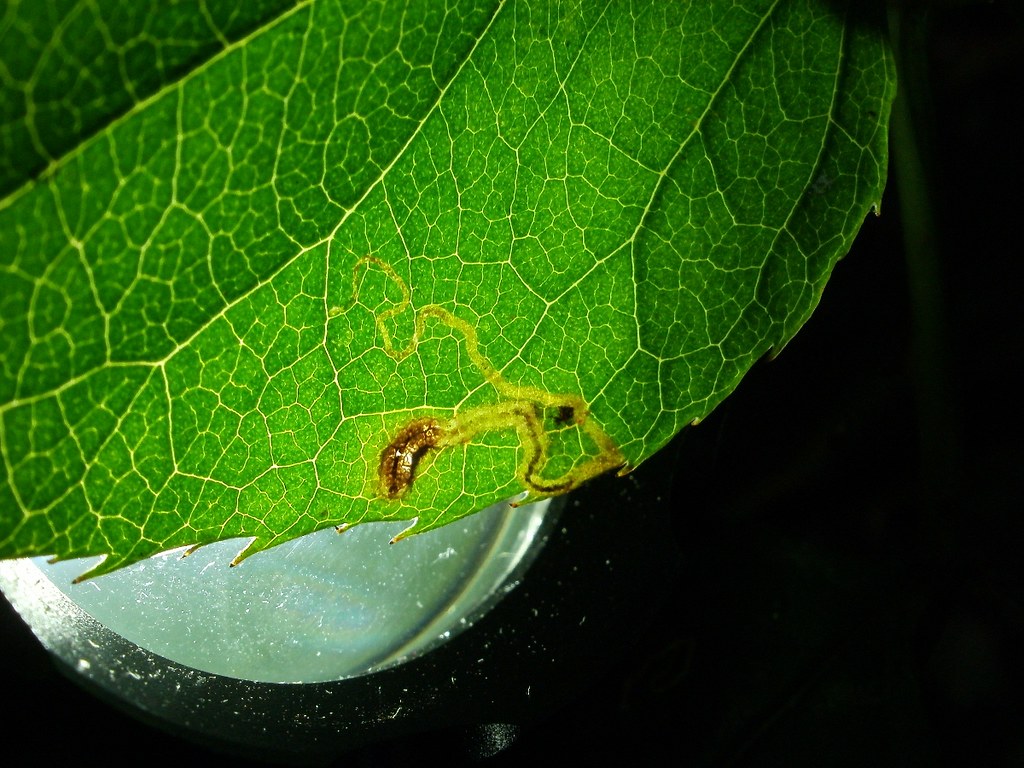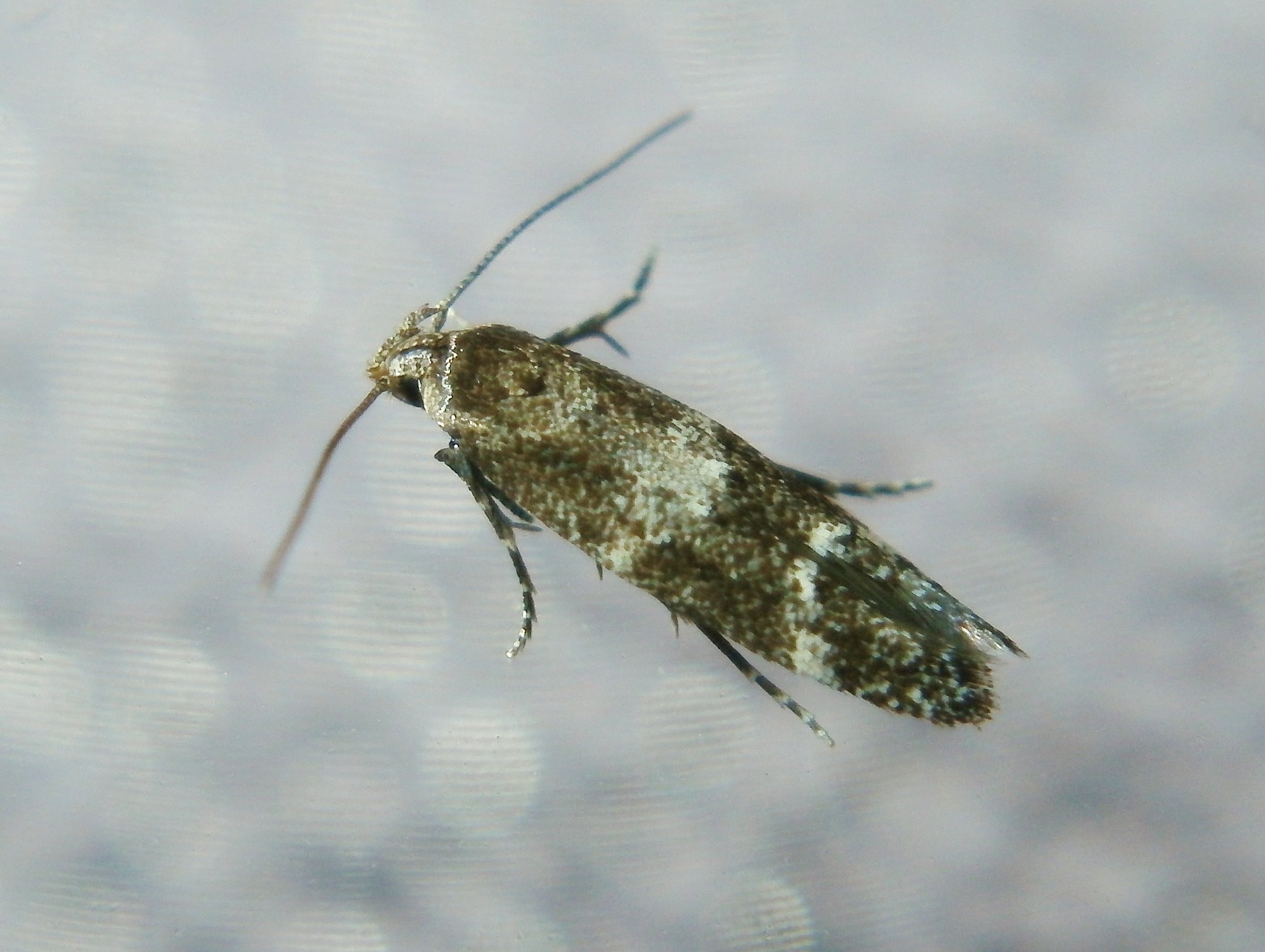| Polar bear eating marshmallows in a snowstorm |
Yes, may I introduce the 25W Blacklight Heath, my humble home-made moth trap, glowing steadfastly yesterday morning after a seventh mothless night out in my back yard/garden in the Springmartin area of west Belfast. It's in its second year of operation and last year pulled in a fair number and variety of species, including this Firethorn Leaf Miner (Phyllonorycter leucographella; a relatively recent arrival to Nornia and as you can see, dwarfed by my cat's hair fibre):
Back to the present, most lepidopterists in the UK running traps in favourable habitats have got something this year, and you can check out their successes in the blog list on the right and at the Back Garden Moths forum (where I spend a lot of time, and where I'll be duplicating the garden moth reports I post here). Still, all agree moth numbers have been down on previous years due to the cold weather.
So have I anything to report from the garden yet? Well as it so happens...
Jan 2013 | Trace records | at home garden, Springmartin HVC39 J3074
Rose Leaf Miner ~ Stigmella anomalella: vacated/failed larval leaf mines on Rose
Stigmella aurella: vacated larval leaf mines on Bramble
 |
| Rose Leaf Miner. As you can see there appears to be the remains of a larva in here, although it could simply be a discoloration of the leaf epidermis |
I haven't included a photo of Stigmella aurella leaf mines for the simple reason that those who don't know it will merely have to make a trip to their nearest bramble bush where they will very likely find at least one, and those who do know it will already be sick to the back teeth of seeing it!
I've also seen a few tenanted mines at Glencairn Park (my local "patch") and Jordanstown.
I've also seen a few tenanted mines at Glencairn Park (my local "patch") and Jordanstown.
I successfully reared four S. aurella larvae (in their mines) to pupation stage last year, from which I got a parasite and three tiny moths (one of which escaped somehow, one of which I kept as a specimen as it died before I could get it back to where I got it at Murlough House, and the other I released at the colony in my garden lest it suffer a similar fate).
That was my first rearing project on this species, which was "Study Species" number 27 of the 30-odd species I've reared over the past three-and-a-half years. That gives you an idea of the work I'll have to do to summarise all the Lepidoptera rearing projects I've done on that "Projects" page I'm planning on doing!
When it comes to biological recording, as I see it, there are basically two kinds of record: live records and trace records. Traces include dead individuals, feeding signs, vacated cocoons etc. Live records go on my year list, trace records don't. That may sound like moon waffle to most people, but I find it a very useful principle to live by.
But before my readership falls asleep, I must move on to my first live garden record of the year...
20 Feb 2013 | Indoors | at home garden, Springmartin HVC39 J3074
Mompha subbistrigella: 1 (Y) (GY)
An overwintering Momphid in the window of our family's upstairs loo. Still counts as a garden record by my rules! (Strangely, no White-shouldered House Moths [Endrosis sarcitrella] or Brown House Moths [Hofmannophila pseudospretella] have showed up yet.)
This, my first macro-moth of the year, was one I'd never seen before, a fantastic furry Noctuid resting on the wall of the youth hostel at Ballintoy. I wrote about it recently on The Caterpillar, before I started this blog.3 Mar 2013 | Day Obs | at Ballintoy VCH39 D0444
Pale Brindled Beauty: 1 (N) (Y) |
| Pale Brindled Beauty |
Also in that post I wrote about my current rearing projects, one of which features the following little fella:
28 Mar 2013 | On vegetation | at home garden, Springmartin HVC39 J3074
Angle Shades: 1L (Ye) (GYe)
 |
| Angle Shades caterpillar on rose |
(That, by the way, is project 3B. I'll get round to talking about my projects some day....)
Another moth recording vagary (which, be ye warned, may send you to sleep) is those Ys and Gs and Ns above. Those are my "list" notation. Moth-ers generally keep life lists or garden lists and often year lists, and they use abbreviations when sharing their finds to indicate that a moth is new for a particular list. Most use NFM/NEW, NFG and NFY (new for me/garden/year).
I was pernickety and pointed out to myself that it's possible to see a new species for the first time in a year outside the garden as an early stage then see the adult, again outside the garden, then later find the adult in the garden and what, may I ask, are you supposed to do then?
So I've developed a "simple" system for my notebook using squares and circles and ticks, which I'll adapt for use on this blog...
(Y) New for year for me (adults)
(Ye) New for year for me (early stage)
(GY) New for year for garden (adults)
(GYe) New for year for garden (early stage)
(N) New for me (all stages)
(n) New for me (adult, after early stage)
(GN) New for garden (all stages, and traces provided they haven't blown in)
This is the corner of my life where I'm obsessive-compulsive about things. Just ignore me if it annoys you!
And after this very long post which took two hours to write and which hopefully sets the scene for what I'm hoping to do with the Lepidoptera Log this year, I'll end on a moth please Carol!
 |
| Pink-barred Sallow, in Murlough NNR, Oct 2012 |
.jpg)


No comments:
Post a Comment